- Author
- A.N. Other and NHSA Webmaster
- Subjects
- History - general, Biographies and personal histories, Obituaries
- Tags
-
- RAN Ships
- HMAS Adelaide I, HMAS Hobart I, HMAS Moresby I, HMAS Swan I, HMAS Shropshire, HMAS J3
- Publication
- September 1991 edition of the Naval Historical Review (all rights reserved)

With his death an historic link with the beginning of the RAN has been severed as Rear Admiral H.A. Showers, CBE was the last survivor of the first entry of Cadet Midshipmen who joined the RAN in 1913 when the College was temporarily housed in Osborne House, North Geelong. He was 92.
On passing out in 1916 at Jervis Bay he was awarded various prizes including the Albert prizes for theoretical and practical engineering. He had also gained his colours for rugby, cricket and rowing.
Aged 17, he became a midshipman on 1 January, 1917 and commenced his seagoing career in World War I as one of five Australian midshipmen posted to the light cruiser HMS GLORIOUS of the Grand Fleet.
The GLORIOUS was, during part of that time, stationed at Scapa Flow. It was a little chilly. To keep fit, and warm, the midshipmen took up boxing. When a Grand Fleet boxing tournament was held, the five Australian midshipmen represented their ship in the five different divisions. Each won his division.
At the end of 1917 he joined submarine K14 at Rosythe. The disaster off May Island at the end of January, 1918 had two significant consequences for my grandfather. First, several years later when he was back in Sydney, he visited the family of his close friend from the Naval College, Dick Cunningham, who had been killed there. Then he met Dick’s sister Jean, whom he subsequently married. Secondly, my grandfather’s own submarine was damaged at May Island and he was given the task of restarting the batteries. He always maintained that the amount of chlorine gas he breathed in at that time forced him to take up smoking, so as to get rid of the taste of the chlorine. It must have been quite a taste, as he continued smoking ardently for the rest of his life.
He was one of the original Australian submariners serving in submarines until 1922 in the North Sea, Mediterranean and Australia. In 1918 he was sent to the “E” Class submarine flotilla based at Harwich and in 1919 was posted to the submarine J3 and was part of the crew bringing her out to Australia. I cannot imagine a more unpleasant task. The journey took three months and six days and only a few days were spent in each port. The submarines had no ice, no fresh bread and no fresh water facilities. When asked why he had chosen submarines, he mentioned that it was primarily due to the fact that he could not bear sleeping in a wet bed. He reasoned that if his bed became wet in the submarine, sleep would be the least of his concerns.
All through those early naval days he played sport whenever he could, representing his ship, flotilla or squadron in rugby, boxing, soccer, hockey and cricket. In 1920, whilst studying at Greenwich and again in 1925 when studying at Portsmouth, he was selected in the squad for the All England Rugby team. Unfortunately, both times he was thwarted by injury.
As a result of his studies in the early 1920s, he was an accomplished engineer, navigator and astronomer. He then pursued his career in the Navy as a navigator. In this time he discovered, in 1927, while fixing the stars from a position here on Garden Island that Sydney was not correctly placed on the map. It took four long nights to prove this to his superior officers; but prove it he did. The maps and Captain H.A. Showers’ s charts of the Barrier Reef made under his supervision while on the MORESBY in 1926-27 were the first of that area since Captain Cook and have only recently been superseded.
He was squadron navigator for the third cruiser squadron of the Royal Navy’s Mediterranean fleet during the Abyssinian crisis. By the outbreak of World War II he had been promoted to Captain and was in command of the SWAN.
He spent the whole of the war in the Pacific, during which he commanded the cruisers HMA Ships ADELAIDE, HOBART AND SHROPSHIRE at various times between 1940 and 1944. On the ADELAIDE in September 1940 he was in charge of the coup by which the Free French Governor of the New Hebrides was taken to New Caledonia to prevent the Vichy Governor from placing that island in enemy hands.




